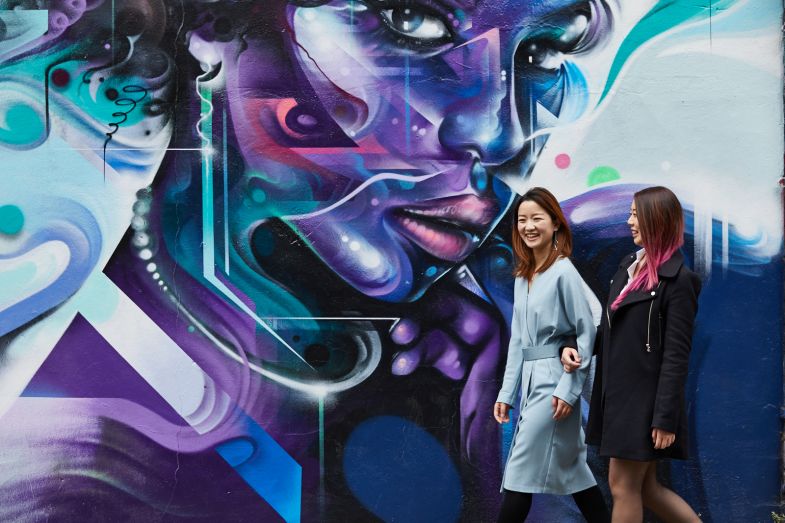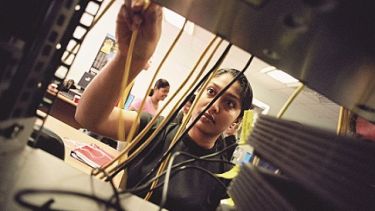What does an Art and Design degree involve?
Art and Design is a huge field in which you could study a diverse range of topics from art history to illustration, and dance to fashion. If you’re creative, imaginative and looking for different outlets to express yourself, then a career in the arts or design could suit you.
Degrees in this area can be vocational and are, generally speaking, coursework based. They’re all about the practical application of your creative skills, exploring your own style and developing any specialist technical knowledge.
Completion of a Foundation course is a useful and sometimes necessary requirement for entry to Art and Design degrees and can also help you to establish which areas of art and design interest you the most. For international students, a pathway programme could be the boost you need to prepare academically for university study in the UK and improve your language skills to the level needed for your degree.

Why should I study Art and Design in the UK?
From renaissance masters to contemporary culture, the works of Leonardo da Vinci, Andy Warhol, Tracey Emin and Banksy are accessible in the galleries – and streets in the case of Banksy – of the UK. By choosing to study Art and Design in the UK, you’ll be immersed in one of the richest cultural heritages in the world.
London boasts some of the best galleries and museums in the world. Big names such as the Tate Modern, the Saatchi Gallery and British Museum house impressive collections, but there are also hundreds of smaller galleries full of hidden treasures. Many of these galleries are also free, making art accessible to students who study here, and providing them with the resources to inspire.
However, it’s not just London which will fuel an art student’s appetite for appreciating renowned artists in world famous galleries. Many towns and cities across the UK have a thriving arts scene. There’s a design festival in Manchester, the Mackintosh House in Glasgow, the Yorkshire Sculpture Park, the Ashmolean Museum in Oxford, the Tate Liverpool, the BALTIC Centre in Gateshead – the list of cultural institutions outside of London is endless!

How do I showcase my talents with an Art and Design degree?
When it comes to careers, the range of occupations you can enter are just as varied as the different areas of Art and Design: TV or theatre production, teaching, curating, performing arts, journalism, fashion, interior design... And with the growth of all things digital, there’s an increasing need for new types of digital artistic creativity – whether that’s website or app designers to computer games animators.
Not only will an Art and Design degree teach you to think creatively and independently, you will develop a wide range of other useful transferable skills such as communication, problem solving, presentation and critical awareness.
It’s essential to develop a portfolio to showcase your own work and ideas outside of your university coursework. This could be done through work experience or volunteering. If art is your thing, then your talent really will help you to stand out more than in most degrees.
Depending on which Art and Design degree you opt for, there may also be opportunities for optional work placements, or participating in competitions and exhibitions – all great ways of promoting yourself, building up your contacts and securing a job or commission.

What can I do with an Art and Design degree?
Your drawing and painting are breath taking, you take inspiring photos or perhaps your ability to design – buildings, clothes, websites – is amazing. Whatever your niche, will having fine-tuned those skills during your degree help you to get a job?
Ultimately, it depends on what your end goal is. Your transferrable skills gained from your degree will make you a more than suitable candidate for the many graduate jobs that are open to students from multiple academic backgrounds. Or you could choose a career that is highly relevant to your degree or relates to a specialisation of your degree. There is nothing to stop you, except for determination and dedication, from becoming an artist who creates and sells their work, for example.
It’s traditionally believed that a career in the creative sector isn’t the best route to a high-paid job, but then again, life isn’t all about money. Often people who work in the arts do so because this is where their interests lie. You too could find a job where you are doing something you’re passionate about, expressing yourself through your creativity, and being paid for it. How great would that be?!
Start your creative career with a university preparation programme:
- International Foundation in Art and Design at INTO London World Education Centre
- International Foundation in Art and Design at INTO Manchester in partnership with Manchester Metropolitan University
- International Foundation in Art, Design and Media or International Year One in Art, Design and Media at INTO University of Gloucestershire
- Graduate Diploma in Media, Humanities and Social Sciences at INTO University of Stirling
Graduate Diploma in Social Sciences and the Arts at INTO City, University of London









